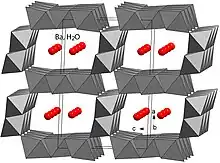| Romanèchite | |
|---|---|
 Romanèchite, from the Marquette County, Michigan, US. | |
| General | |
| Category | Oxide minerals |
| Formula (repeating unit) | (Ba,H2O)2(Mn4+,Mn3+)5O10 |
| IMA symbol | Rmn[1] |
| Strunz classification | 4.DK.10 |
| Crystal system | Monoclinic |
| Crystal class | Prismatic (2/m) (same H-M symbol) |
| Space group | C2/m |
| Identification | |
| Mohs scale hardness | 6–6.5 |
| Luster | Submetallic |
| Streak | Blue-black |
| References | [2][3][4] |

Romanèchite ((Ba,H2O)2(Mn4+,Mn3+)5O10) is the primary constituent of psilomelane, which is a mixture of minerals. Most psilomelane is not pure romanechite, so it is incorrect to consider them synonyms. Romanèchite is a valuable ore of manganese, which is used in steelmaking and sodium battery production.[6] It has a monoclinic crystal structure, a hardness of 6 and a specific gravity of 4.7–5. Romanèchite's structure consists of 2 × 3 tunnels formed by MnO6 octahedra.[5][7]
It is commonly associated with hematite, barite, pyrolusite, quartz and other manganese oxide minerals. It has been found in France, Germany, England, Brazil, Russia, India, and various parts of the United States, including Arizona, Virginia, Tennessee and Michigan, and sites throughout the Appalachian Valley and Ridge.[8] It occurs also in ferromanganese nodules from Lake Baikal.[9]
 Bicolor (left) and tricolor (right) X-ray fluorescence maps of the distribution of Mn, Fe, and Ba in a ferromanganese nodule from Lake Baikal. Size = 5 mm (H) × 3 mm (V).[9]
Bicolor (left) and tricolor (right) X-ray fluorescence maps of the distribution of Mn, Fe, and Ba in a ferromanganese nodule from Lake Baikal. Size = 5 mm (H) × 3 mm (V).[9]
References
- ↑ Warr, L.N. (2021). "IMA–CNMNC approved mineral symbols". Mineralogical Magazine. 85 (3): 291–320. Bibcode:2021MinM...85..291W. doi:10.1180/mgm.2021.43. S2CID 235729616.
- ↑ Romanechite, Webmineral.com
- ↑ Romanechite, Mindat.org
- ↑ Harlow G, Peters J, Prinz M (1977). "Oxides and Htdroxides.". Simon & Schuster's Guide to Rocks and Minerals. New York: Simon & Schuster.
- 1 2 Turner S and Post JE (1988) American Mineralogist 73: 1155–1161
- ↑ Li JY, Wu XL, Zhang XH, Lü HY, Wang G, Guo JZ, et al. (October 2015). "Romanechite-structured Na(0.31)MnO(1.9) nanofibers as high-performance cathode material for a sodium-ion battery". Chemical Communications. 51 (80): 14848–51. doi:10.1039/C5CC05739F. PMID 26344149.
- ↑ Post JE (March 1999). "Manganese oxide minerals: crystal structures and economic and environmental significance". Proceedings of the National Academy of Sciences of the United States of America. 96 (7): 3447–54. Bibcode:1999PNAS...96.3447P. doi:10.1073/pnas.96.7.3447. PMC 34287. PMID 10097056.
- ↑ Carmichael SK, Doctor DH, Wilson CG, Feierstein J, McAleer RJ (2017-09-01). "New insight into the origin of manganese oxide ore deposits in the Appalachian Valley and Ridge of northeastern Tennessee and northern Virginia, USA". GSA Bulletin. 129 (9–10): 1158–1180. doi:10.1130/B31682.1. ISSN 0016-7606.
- 1 2 Manceau A, Kersten M, Marcus MA, Geoffroy N. and Granina L (2007) "Ba and Ni speciation in a nodule of binary Mn oxide phase composition from Lake Baikal". Geochimica et Cosmochimica Acta, 71: 1967–1981. doi:10.1016/j.gca.2007.02.007